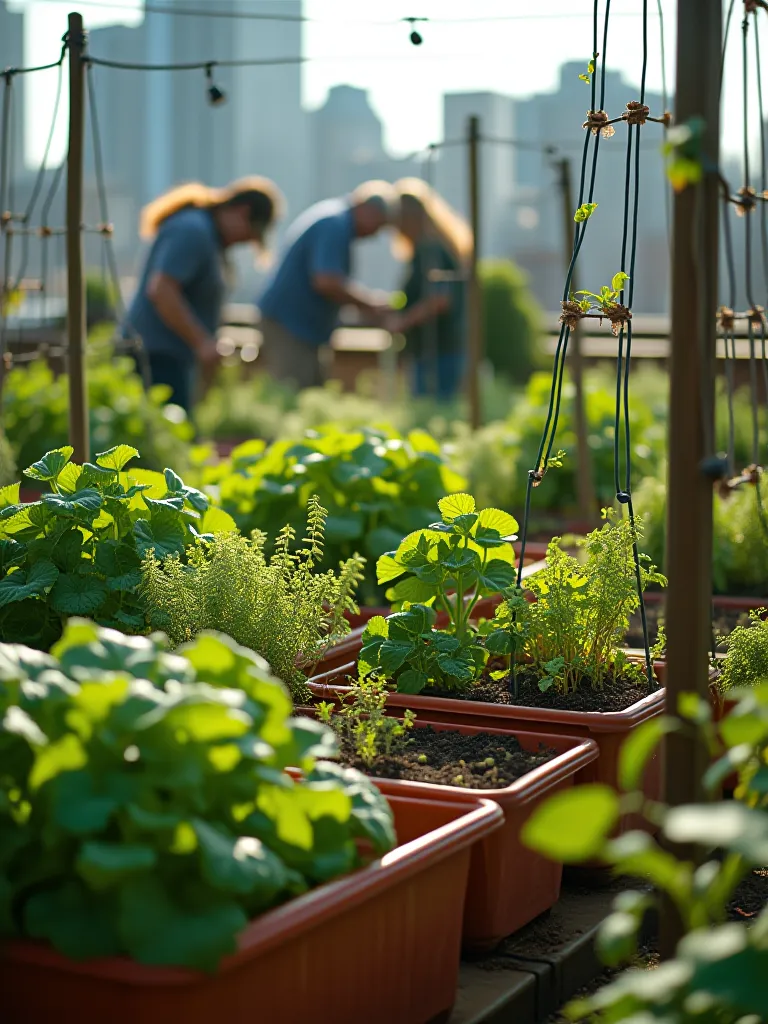In the realm of urban sustainability, supporting vegetables in containers emerges as a powerful solution for those yearning to cultivate their food in limited spaces. As we navigate the challenges of modern living, the art of container gardening offers a beacon of hope, transforming balconies, patios, and even windowsills into thriving ecosystems of fresh produce. This comprehensive guide to container vegetable gardens will illuminate the path to creating a bountiful harvest, even in the most compact urban environments.
Supporting vegetables in containers is not merely about aesthetics; it’s a fundamental practice that can dramatically enhance the health, productivity, and resilience of your plants. By providing the right support structures, we create a harmonious balance between nature and design, allowing our urban gardens to flourish vertically and maximizing the potential of every square inch. Let’s embark on this journey to transform your living space into a verdant oasis of sustainable abundance.

Key Takeaways
- Supporting vegetables in containers is a cornerstone of successful urban gardening, enhancing plant health and productivity.
- Choosing the right support structures, such as trellises, stakes, and cages, is crucial for different types of vegetables.
- Regular maintenance and adjustments of support systems ensure optimal growth and prevent potential damage to plants.
- Vertical gardening techniques maximize space utilization and yield in small urban environments.
- Integrating decorative support options can transform your container garden into a visually stunning and functional space.
Importance of Supporting Vegetables
Benefits of Plant Supports
Supporting vegetables in containers is akin to providing a sturdy scaffold for a growing city. Just as urban planners design infrastructure to support the vertical growth of metropolises, we must engineer our container gardens to reach new heights—literally. By implementing thoughtful support systems, we create a microenvironment that mimics the natural climbing patterns of many vegetable species, allowing them to thrive in ways that defy the constraints of urban living.
The benefits of supporting vegetables in containers extend far beyond mere space efficiency. When plants grow vertically, they engage in a dance with gravity and light, developing stronger stems and more robust root systems. This vertical orientation not only enhances the structural integrity of the plant but also dramatically improves air circulation—a crucial factor in the humid microclimates of container gardens. Improved airflow acts as a natural defense mechanism, reducing the risk of fungal diseases and creating a more resilient ecosystem within your urban oasis.

Airflow and Disease Prevention
In the realm of container gardening, airflow is the unsung hero of plant health. By supporting vegetables in containers and encouraging vertical growth, we create channels for air to move freely among the foliage. This gentle breeze serves multiple purposes: it helps regulate temperature, reduces humidity, and discourages the settlement of harmful pathogens on leaf surfaces.
Think of your container garden as a miniature city, where each plant is a building. Just as urban planners design streets and alleyways to facilitate the flow of people and resources, we must create pathways for air to circulate freely among our plants. This strategic design not only prevents the stagnation of humid air—a breeding ground for mold and mildew—but also strengthens the plant’s natural defenses against pests and diseases.
Maximizing Growth and Yield
Supporting vegetables in containers is not just about maintaining plant health; it’s about unleashing their full productive potential. By guiding plants upward, we tap into their innate ability to maximize photosynthesis. Every leaf becomes a solar panel, efficiently capturing sunlight and converting it into the energy needed for robust growth and bountiful harvests.
Moreover, vertical growth allows for higher planting densities, transforming small urban spaces into productive mini-farms. This efficient use of space is not just about quantity; it’s about quality. Plants grown with proper support tend to produce fruits and vegetables that are more uniform in shape and size, making harvesting easier and more satisfying. As we support our plants, we’re not just growing food; we’re cultivating a sustainable lifestyle that challenges the limitations of urban living.

Choosing the Right Support Structures
Types of Trellises
When it comes to supporting vegetables in containers, the choice of trellis can make all the difference between a thriving vertical garden and a tangled mess of vines. Trellises are the urban planner’s answer to the challenge of vertical growth in confined spaces. They come in a variety of materials and designs, each offering unique benefits for different types of vegetables and container setups.
Wooden trellises, with their natural aesthetic, blend seamlessly with the organic feel of a garden. They’re perfect for creating a rustic, eco-friendly vibe in your urban oasis. However, like any wooden structure exposed to the elements, they require regular maintenance to prevent rot and extend their lifespan. Metal trellises, on the other hand, offer durability and strength, making them ideal for supporting heavier vegetables like tomatoes or squash. Their sleek design can add a modern touch to your container garden, complementing contemporary urban aesthetics.
For those seeking versatility and ease of use, plastic trellises present an attractive option. Lightweight and often collapsible, they’re perfect for the urban gardener who needs to reconfigure their space frequently or wants to experiment with different container gardening year-round setups. When selecting a trellis, consider not just the material but also the design. A-frame trellises offer stability and are excellent for vining plants like peas or beans. Flat panel trellises work well against walls, maximizing vertical space in tight corners. Obelisk designs add an architectural element to your garden, serving as both functional support and artistic centerpiece.
Using Stakes Effectively
Stakes are the silent guardians of the container garden, providing crucial support to plants that might otherwise succumb to their own weight or environmental pressures. The key to effectively supporting vegetables in containers with stakes lies in understanding the growth patterns and needs of your plants.

When selecting stakes, height is paramount. Choose stakes that are tall enough to support the full mature height of your plants. Bamboo stakes offer a sustainable option that aligns with eco-conscious gardening practices. Their natural strength and lightweight nature make them ideal for a wide range of vegetables. Metal stakes, while less aesthetically pleasing, provide unparalleled durability and can be reused season after season.
The art of staking goes beyond simply inserting a rod into the soil. It’s about creating a symbiotic relationship between plants and support. Place stakes early in the growing season to avoid disturbing established root systems. As your plants grow, gently guide them along the stake using soft ties. This process, akin to urban planning, requires foresight and adaptability. Regular check-ins and adjustments ensure that your plants receive consistent support throughout their growth cycle, leading to healthier plants and more abundant harvests.
Cages for Stability
In the urban jungle of container gardening, cages emerge as versatile structures that offer both support and protection for your vegetables. Think of cages as miniature high-rise buildings, providing a framework within which your plants can grow and thrive. They’re particularly effective for supporting vegetables in containers that tend to sprawl or produce heavy fruits, such as tomatoes, peppers, and eggplants.
The beauty of cages lies in their ability to support plants from all angles, distributing weight evenly and preventing the collapse that can occur with single-stake methods. When selecting cages, consider both the mature size of your plants and the dimensions of your containers. A well-chosen cage should allow for ample growth while fitting comfortably within the confines of your container.

Material choice for cages is crucial. Wire cages offer durability and excellent airflow, essential for preventing fungal diseases in humid environments. Collapsible fabric cages provide flexibility, allowing you to adjust the support as your plants grow. For the eco-conscious gardener, repurposed materials can be transformed into unique and functional cages, adding a personal touch to your urban garden while promoting sustainability.
Supporting Specific Vegetables
Tomatoes and Heavy Fruits
Tomatoes, the crown jewels of many container gardens, require thoughtful support to reach their full potential. Supporting vegetables in containers, especially heavy-fruiting varieties like tomatoes, is an exercise in engineering and foresight. The goal is to create a support system that can bear the weight of fully laden branches without compromising the plant’s access to sunlight and air.
For indeterminate tomato varieties, which can grow to impressive heights, sturdy cages or tall stakes are essential. These supports should be installed at the time of planting to avoid root disturbance later. As the tomato plant grows, gently guide the main stem and branches along the support structure, securing them with soft ties. This not only prevents branches from breaking under the weight of developing fruits but also keeps the plant upright, maximizing exposure to sunlight and improving air circulation.
For determinate varieties, which tend to be bushier, a combination of stakes and twine can create a supportive cage-like structure. This method often called the Florida weave, involves placing stakes at regular intervals along the row of plants and weaving twine between them to create horizontal supports at various heights. This technique is particularly effective in container gardens where space is at a premium, as it allows for dense planting while maintaining excellent support and airflow.

Cucumbers and Vining Plants
Cucumbers and other vining plants present a unique challenge in container gardening, but with the right support, they can transform vertical spaces into lush, productive green walls. The key to successfully supporting vegetables in containers like cucumbers lies in understanding their growth habits and providing structures that complement their natural tendencies to climb and sprawl.
Trellises are the go-to support for cucumbers, offering a vertical playground for these enthusiastic climbers. A-frame or lean-to-trellis designs work exceptionally well, providing ample space for vines to spread while keeping fruits off the ground. As cucumber vines grow, gently train them onto the trellis, using soft plant ties to secure the main stem. The tendrils of the plant will naturally grasp onto the trellis, but occasional guidance ensures even coverage and prevents tangling.
For compact container gardens, consider using expandable fan trellises or even repurposed materials like old ladder rungs to create unique vertical supports. These structures not only support the weight of developing cucumbers but also improve air circulation and make harvesting container vegetables a breeze. By lifting the fruits off the soil, you reduce the risk of rot and make it easier to spot and pick cucumbers at their peak freshness.
Beans and Climbing Varieties
Beans, with their vigorous climbing habits, are perfectly suited for vertical gardening in containers. Supporting vegetables in containers like pole beans requires tall, sturdy structures that can withstand the weight of mature plants laden with pods. The key is to provide support that allows the beans to climb naturally while maximizing your limited space.

Teepee-style supports, created by lashing together three or four tall bamboo poles, offer an elegant solution that doubles as a decorative element in your container garden. As the beans grow, they will spiral around the poles, creating a living green sculpture. For a more space-efficient option, consider using a single tall pole with horizontal crosspieces, mimicking the structure of a ladder. This design allows for multiple plants to climb the same support, maximizing your yield in a small footprint.
String trellises, easily created by running twine vertically from the container to overhead support, provide another flexible option for supporting climbing beans. This method is particularly effective for container gardens on balconies or patios, where the overhead structure of the building can be utilized as an anchor point. As the beans climb, they create a beautiful, productive privacy screen, transforming your urban space into a green sanctuary.
Tips for Effective Support
Positioning and Installation
The art of supporting vegetables in containers begins with strategic positioning and installation of support structures. This foundational step sets the stage for a thriving vertical garden, maximizing both space and sunlight utilization in your urban oasis.
When positioning supports, consider the sun’s path across your container garden. Align trellises and stakes to ensure that climbing plants receive optimal sunlight throughout the day. For north-facing spaces, position supports at the back of containers to prevent shading of smaller plants. In contrast, south-facing gardens might benefit from supports placed centrally, creating a natural canopy that protects more delicate plants from intense afternoon sun.

Installation timing is crucial. Ideally, install support structures at the time of planting or shortly thereafter. This approach minimizes root disturbance and allows young plants to adapt to their supports from the start. When installing stakes or trellises, ensure they are anchored securely in the container. For heavy structures, consider extending the support through the container into the ground beneath for added stability, especially in windy urban environments.
Maintenance and Adjustments
Supporting vegetables in containers is an ongoing process that requires regular attention and adjustment. As your plants grow and develop, their support needs will evolve, necessitating a dynamic approach to maintenance.
Regularly inspect your support structures for stability and signs of wear. Tighten loose ties and replace any that have become brittle or damaged. As plants grow, gently guide new growth along the supports, using soft plant ties or clips to secure stems without causing damage. This process, akin to pruning a bonsai, shapes your plants’ growth patterns and ensures even distribution across the support structure.
Be prepared to make adjustments as the season progresses. Some fast-growing vines may outpace their initial supports, requiring extensions or additional structures. For heavy-fruiting plants like tomatoes, you may need to add extra support to branches bearing significant weight. This ongoing dialogue between gardener and garden ensures that your plants receive consistent support throughout their lifecycle, leading to healthier growth and more abundant harvests.
Decorative and Functional Options
Supporting vegetables in containers doesn’t mean sacrificing aesthetics for functionality. In fact, with a creative approach, support structures can become striking design elements that enhance the visual appeal of your urban garden while fulfilling their practical role.

Consider integrating decorative elements into your support structures. Painted bamboo stakes in vibrant colors can add pops of interest to the greenery. Wrought iron trellises, with their intricate designs, can serve as focal points in your container garden, supporting plants while doubling as outdoor art. For a cohesive look, choose supports that complement the style of your containers and surrounding decor.
Functional art in the form of sculptural supports offers another avenue for creative expression. Repurposed materials like old ladders, bicycle wheels, or even antique bed frames can be transformed into unique trellises that tell a story while supporting your climbing vegetables. These unconventional supports not only provide excellent functionality but also serve as conversation starters, bridging the gap between urban agriculture and art.
By thoughtfully selecting and integrating decorative support options, you transform your container garden into a living gallery—a space where form and function merge to create a vibrant, productive urban ecosystem that nourishes both body and soul.
Final Remarks
As we conclude our exploration of supporting vegetables in containers, it becomes clear that this practice is more than just a gardening technique—it’s a philosophy that embodies the spirit of urban sustainability. By embracing vertical gardening and providing thoughtful support to our plants, we not only maximize the productivity of small spaces but also create harmonious ecosystems that bring nature into the heart of our urban environments.
The journey of supporting vegetables in containers is one of continuous learning and adaptation. As you apply these principles to your garden, remember that each plant, each container, and each urban space presents unique opportunities and challenges. Embrace this diversity and let it inspire creative solutions that work for your specific context.

As you tend to your vertical gardens, training vines along trellises and guiding tomatoes up sturdy cages, take a moment to appreciate the larger impact of your efforts. You’re not just growing food; you’re cultivating a more sustainable way of living. You’re proving that even in the most space-constrained urban environments, it’s possible to create abundance and connect with the natural world.
So, as you look out over your thriving container garden, with vegetables reaching skyward supported by a framework of your design, take pride in your role as an urban agriculturist. You’re part of a growing movement that’s redefining what’s possible in city living, one container at a time. Keep experimenting, keep learning, and above all, keep growing. Your urban oasis is a testament to the power of human ingenuity and nature’s resilience, working in harmony to create a greener, more sustainable future for all.






